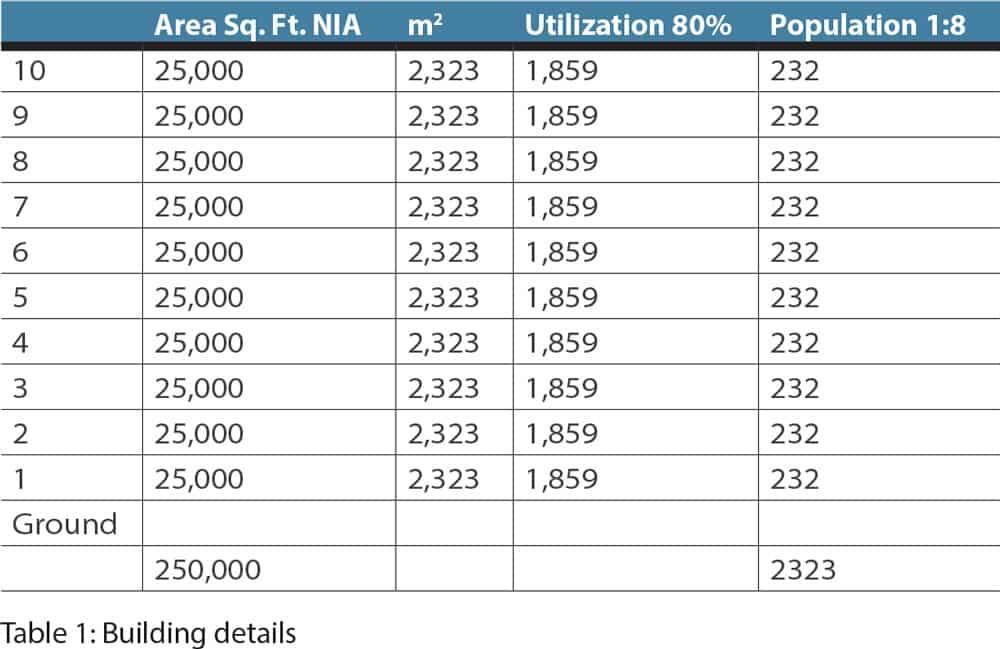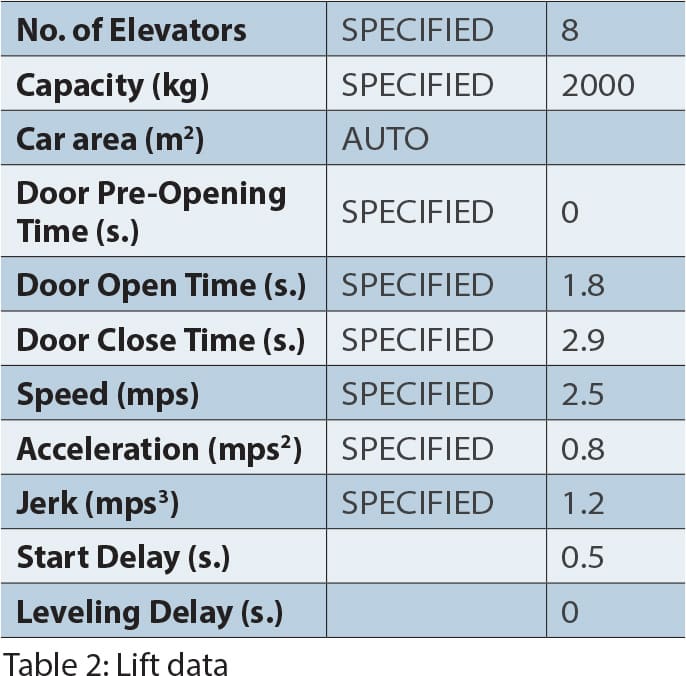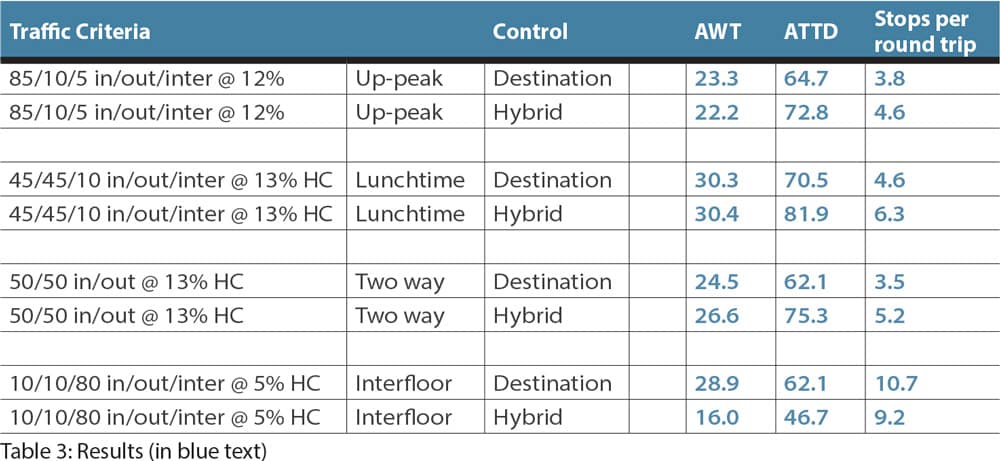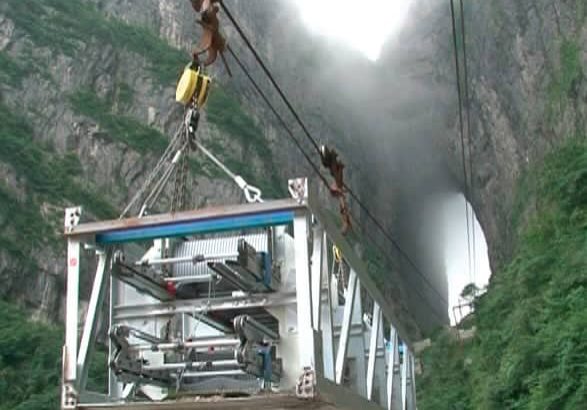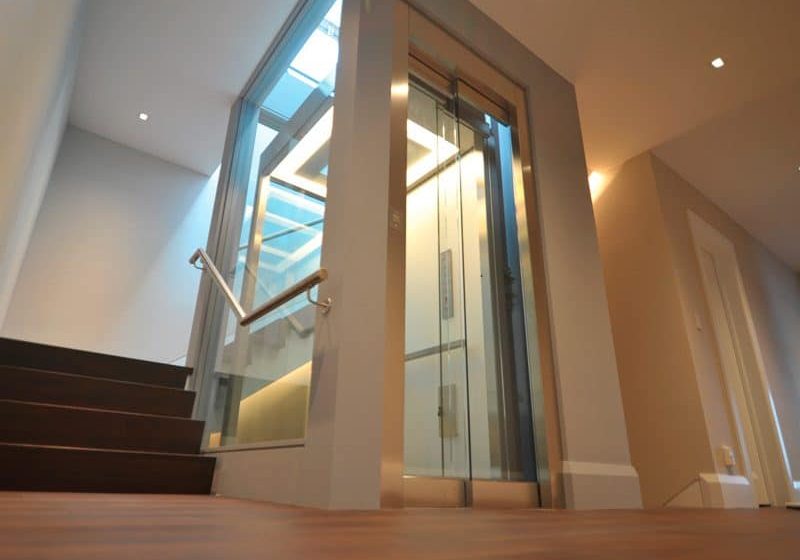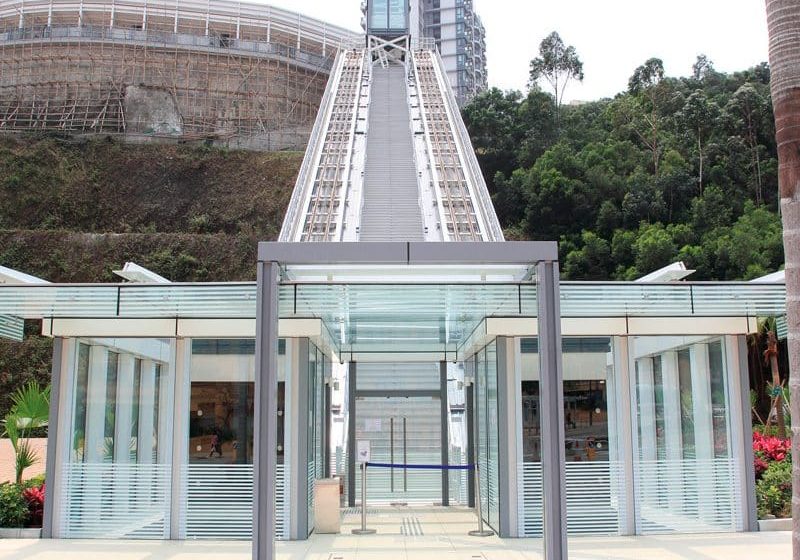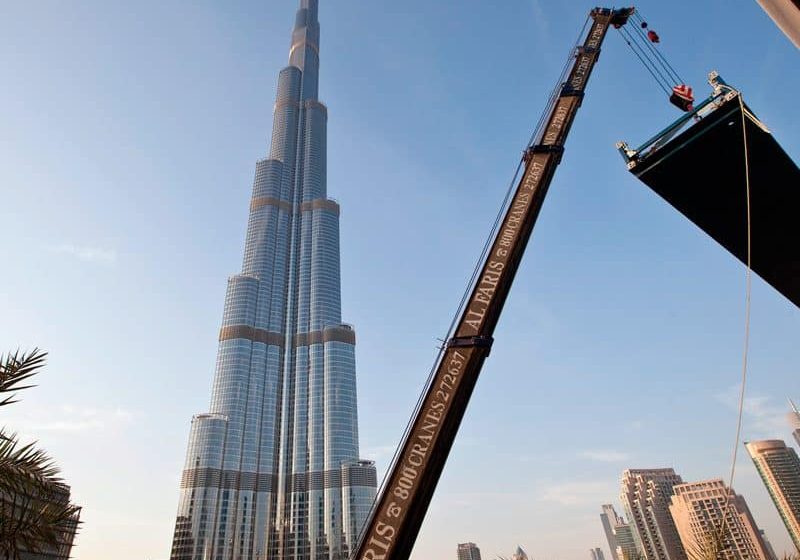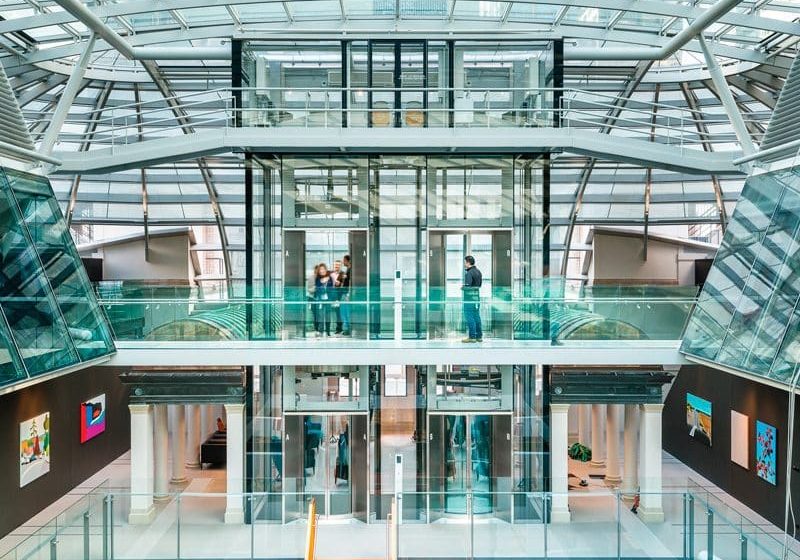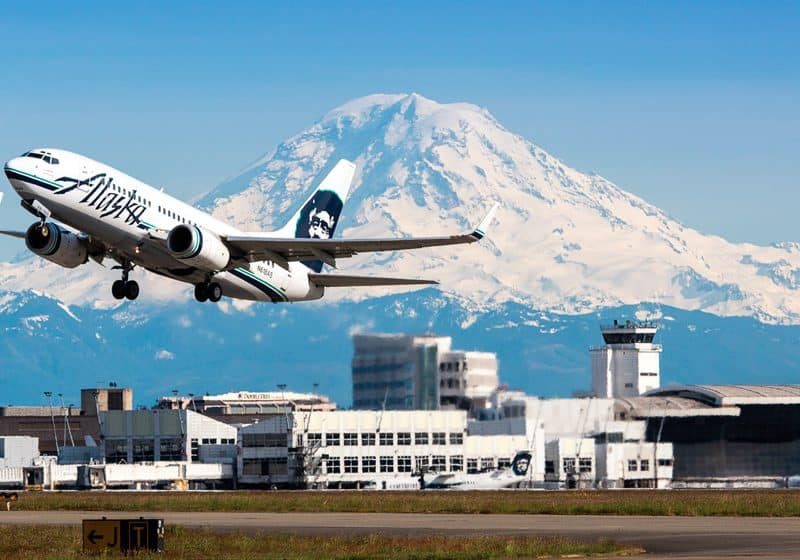How these combinative systems compare to dedicated DCSes in office buildings
This article was first published at the Fourth Symposium on Lift & Escalator Technologies (www.liftsymposium.org) prior to editing by ELEVATOR WORLD. . . . Editor
In recent years, destination control systems (DCSes) have been embraced by all the major and many independent manufacturers. This period follows DCSes having sat at the margins of the industry with only one company actively promoting their use. As that use has risen, the known benefits of providing an up-peak booster have become a major factor in DCSes being specified. However, with their increased use has come a recognized perception that, while providing benefits for up-peak performance, they are not as efficient at handling two-way and interfloor traffic. This has resulted in some manufacturers offering hybrid group systems, whereby destination control is used to dispatch lifts from the main lobby but utilizing a conventional two-button system to call lifts on the upper floors, with active car call buttons by which to select the destination floor.
This article compares the efficiency of hybrid systems with dedicated DCSes across a variety of office building applications. This scope is limited to modern office buildings and does not consider their application in other environments, such as hotels or hospitals. The article also looks at the human factors that present barriers to hybrid systems. Its purpose is to try to establish if the use of hybrid systems is more efficient in dealing with two-way and interfloor traffic than DCSes, and, if so, if there are any penalties in terms of service provision. In addition, it seeks to explore the barriers and perceptions of building users when confronted with a hybrid system and how these issues might be addressed.
Conventional Control
From the outset, it should be considered that the use of conventional two-button control and hybrid systems have limitations in terms of their application. The main areas of limitations are:
- An eight-car group maximum (four cars opposite four) for groups of up to four cars in a single line.
- Where all lifts do not serve all floors in the building
Taking each of the above, in turn:
- Conventional/hybrid systems are really only practical for groups where the maximum number of lifts in a single line does not exceed four. This obviously means that the maximum number of lifts in a group should not exceed eight, as noted. With a lobby length of 11.25 m, for a four-car single line of lifts and a distance between the centers of adjacent lift doors of 2.85 m, adding a further 2.7 m to the length of the lobby has a significant impact, given the average walking speed of 1.25-1.6 mps (Figure 1).
Once a line of four lifts is exceeded, crowded lobbies become too long for people to navigate effectively, and difficulties arise with accessing lifts within reasonable walking times. This is especially difficult for those with visual and mobility impairment. It also has an effect on the system’s efficiency, as door dwell times are increased, and lift performance is reduced.
With long lobbies, the question of lift arrival indication is also an issue, as a more prominent form of signage is required with high levels of audibility for arrival gongs. While such notification as raised arrows may be acceptable, highly audible arrival gongs can be obtrusive, especially where lifts open directly into occupied accommodation. Add to this the undemocratic way in which people access the lifts (i.e., those nearest can board first, while those perhaps waiting the longest may be left at the lobby), and the limitations become apparent.
- Where buildings are designed such that not all lifts in the group serve all floors, conventional systems may require special landing call buttons and services to cater to passengers traveling to floors served by fewer lifts. In some cases, the arrangement is extremely complex (Figure 2), and it becomes almost impossible to provide an effective service with conventional control systems. Even with less complex configurations, there is an adverse impact on lift performance in terms of handling capacity and waiting times to the floors served by fewer lifts. In these circumstances, DCSes are far better at managing traffic to such floors.
Destination Control
The use of DCSes as a means of providing improved performance during the up-peak period is now well established. With higher saturation points compared to those of conventional systems, they are ideal to boost up-peak periods. Their tangible benefits are seen in terms of better passenger management at the main lobby, together with shorter journey times and a reduction in the number of stops before reaching the final destination. This equates to shorter round-trip times and increased handling capacity.
Since all these DCS features are seen as positives, the result has been the frequent use of DCSes as the default group control system in large office buildings with multicar groups. There is, however, the question that, while providing enhanced up-peak performance, DCSes are not as effective at managing two-way and interfloor traffic. The basis of this is that, while it is easy to group passengers traveling to the same destination at one point, in the main lobby, this is far more difficult to achieve when passengers are located on different floors and fewer in number. The perception is that longer waiting times are experienced by passengers moving between floors as the DCS constantly tries to match passengers on different floors to common destinations. The dynamic of upper-floor traffic is constantly changing between two way and interfloor, and the system needs to be able to respond to these changes, while providing the user with an almost instant car allocation.
The ability of some DCSes to effectively manage the dynamics of upper floor traffic, within the constraints of the basic destination template, is difficult. The system is inflexible in terms of call reallocation (discussed later), and the system constraints limit the ability to provide the most responsive service levels. This leads to a reduction in handling capacity, accompanied by increased waiting times.
Hybrid Systems
Hybrid systems appear to offer the best of both worlds, with destination dispatching from the ground floor and the benefits of conventional control in the upper part of the building. Destination dispatching is available from more than just the main lobby in some hybrid systems. This arrangement appears ideal for buildings with restaurant, amenity and, perhaps, function floors located on the upper levels.
One of the key factors and benefits of conventional control systems is the ability to reallocate landing calls. When a landing call is registered, the call is allocated to a car the system computes will provide the fastest response time. If the allocated car is delayed at any point, the call can be reallocated to a different lift. While this process is taking place within the group control system, the waiting passenger is unaware of any change of allocation and informed of the lift’s impending arrival only when the hall lantern illuminates as the car approaches the floor.
This is in contrast to DCSes, in which the almost instant allocation of a lift is fixed. Once the passenger is directed to a particular lift, he or she expects the lift to arrive shortly. However, if the lift is delayed, there is no mechanism to inform the passenger the call has been reallocated. In these circumstances, the frustrated passenger’s tolerance often expires, and he or she reenters his or her call, only to be directed to a different lift or, worse, back to the original lift. This has a negative impact on the user’s perception and view of the service being provided and is one of the major difficulties encountered with DCSes.
From this, we can start to see some of the benefits of the hybrid system. Management and grouping of passengers at the main lobby and the elimination of the call reallocation problem on the upper floors appear to offer the best of both systems and carry a certain degree of logic, in terms of a group system operation. However, it should be appreciated this can still happen at the main lobby or on any floor where the destination facility is available.
Comparing Hybrid Systems and DCSes
In examining the use of hybrid systems, it is necessary to try to understand the benefits and drawbacks of each system, both technically and in terms of the passenger experience.
DCS
Positives
- Identifies number of passengers
- Groups passengers according to destination
- Shorter round-trip times during up-peak
- Improves waiting time at the main lobby*
- Efficient use of lifts
- Improves up-peak handling capacity
- Better allowance for passengers with disabilities
- Manages people in the lobbies
* Especially if passenger demand is close to or exceeds handling capacity of conventional systems
Negatives
- Relies on all passengers entering their destination
- Passengers have no control within the car
- Passengers have to move to the landing to change their destination floor
- Ghost calls reduce efficiency
- Does not signal call reallocation
- Unpopular with some users
- Perceived inefficiencies in handling interfloor traffic
- People try to beat the system – repeated call request or group call function used.
Hybrid System
Positives
- Identifies number of traveling passengers at the main floor
- Groups passengers according to destination at the main floor
- Provides up-peak booster feature
- Manages people at the main lobby
- Good interfloor traffic handling
- Allows space for users with disabilities from the ground floor
- Can use hall-call allocation on upper floors with heavy traffic (restaurants, meeting floors, etc.)
- Allows call reallocation for lifts responding to upper-floor landing calls.
- May carry a cost advantage over a full DCS
Negatives
- May be confusing for users
- Different landing fixtures at ground and other floors
- Car buttons active/inactive at different times
- Not as effective at allowing use by passengers with disabilities leaving upper floors
- People try to beat the system – entering the car and waiting for the car operating panel (COP) to become active.
- Up to eight car groups only
- Does not know how many passengers are to be transported from upper floors
- Passengers may experience more intermediate stops than with DCSes.
- May not be suitable in groups where all lifts do not serve all floors.
Simulations
In addition to understanding the benefits and drawbacks, the relative performance of each system is assessed through simulation in identical applications. The results, using set criteria and performance standards for a theoretical building with a typical service requirement, are set out below.
A 10-floor, 250,000-sq.-ft building with a space utilization of 80% and population density of one to 8 m² is considered. (Utilization is the expression of occupied space on each floor, with 20% floor space being used for circulation, cabinets, copiers, etc.) The selected measurement criteria are:
- Up-peak traffic
- Lunchtime traffic
- Two-way traffic; 50% incoming and 50% outgoing
Intense interfloor traffic; 10% incoming, 10% outgoing and 80% interfloor
The two-way traffic in “3” above represents a building with a diversified tenancy, where there is no interfloor traffic. Conversely, criterion “4” represents a consolidated tenancy with high levels of interfloor traffic. The criteria used in both “3” and “4” are not based on any guidance references but are purely means of comparing the performance delivery of each system. In both “3” and “4,” the lifts are operating outside of the up-peak and lunchtime period.
The performance measurements assessed are average waiting time, time to destination and average stops per round trip. Note that the simulations for up-peak and lunchtime are based on the criteria as set out in the 2014 draft British Council for Offices guide.[3] The profile is constant traffic with a 1-hr. simulation period. All simulations were carried out using Elevate traffic-simulation software (version 8.17). The “Destination Control (ACA)” dispatcher was used for destination-control simulations. For hybrid simulations, the “Mixed Control (Enhanced ACA)” dispatcher was used.
The use of Elevate software provides a set of results that may differ from those achieved by a supplier’s own simulations. For the purposes of this paper, however, the simulation results achieved using Elevate provide the basis of discussion. The data matrices in the tables detail the building and lift criteria applied in the simulations.
The results show there is significant reduction in waiting times and times to destination with a hybrid system when catering for a high level of interfloor traffic. In the other traffic patterns, (up-peak, lunchtime and two-way), the waiting times are not too dissimilar between the two systems. However, the time to destination is longer with the hybrid system as a result of the increased number of stops experienced during the round trip. This suggests the hybrid is working harder, as it is achieving similar waiting times with increased numbers of stops, reflecting a higher handling capacity.
The general results show that a hybrid system does mean shorter waiting and journey times for interfloor traffic. The results of the up-peak and lunchtime simulations show the DCS performs better in terms of time to destination and fewer intermediate stops, while waiting times are similar to those of the hybrid system.
With respect to the passenger’s experience of intermediate stops, it is important to distinguish between the numbers of stops the lift makes and the number of intermediate stops experienced by each passenger. With passengers entering and leaving the lift at different floors, the number of intermediate stops experienced is not the same for each individual. To arrive at the average, it is necessary to apply a weighting based on the number of passengers who start the journey together and those who leave the lift at each stop. This will obviously show that the number of intermediate stops experienced by each passenger is different, but the average is less than the number of intermediate stops made by the lift. This is an important factor when assessing the passenger experience and a key element in the marketing of buildings. To effectively gauge the average number of stops passengers experience, it is necessary to track each individual’s entire journey.
The results indicate hybrid systems are better suited to buildings with a single tenancy, where interfloor traffic levels are likely to be higher than, perhaps, a diversified tenancy building. This obviously poses a question related to the future proofing of the building.
Program Modes
Historically, conventional group control systems have sought to manage demand based on responding to the traffic pattern. Up-peak, down-peak and two-way (balanced) traffic have been familiar terms in lift program language, with the group control system monitoring demand and applying a preprogramed response to the pattern of usage.
Conventional group control usage was detected by monitoring landing and car calls, together with measuring the car load. However, the response could be somewhat clumsy and relied on high levels of maintenance to ensure the systems functioned correctly. This changed somewhat with the advent of lifts working in “zones” throughout the building. Up-peak was retained as a “program” to respond to the morning traffic, but once this subsided, the lifts would revert to a “zoning” operation, whereby the lifts were driven by demand within the zones.
The introduction of microprocessor technology changed the approach to group control, whereby call allocation was introduced and greatly improved performance and response times. This was achieved by the use of greater computing power to assess a much wider level of information and start to match response to demand. Coincident car and landing calls, assessing the “allocated workload” of each car and knowing the exact position of each car in the shaft allowed systems to operate at a far higher level and provide a much better level of service to building users. “Relative system response” became a key measurement of performance.
The concept of using different operating modes or programs is still used in modern microprocessor-based systems, with the “up-peak” used on conventional systems the most obvious. However, the ability of systems to have a completely flexible and seamless response to changing traffic patterns would appear to offer the best solution in terms of system response, given any “program” is operating within the parameters of a predefined criteria, however flexible that may be. By extension, DCSes provide the better means of control, given their ability to understand the pattern of demand before passengers enter the lift. This is, of course, conditional on all passengers entering their destination.
Any DCS, even those working within modes or programs, is still constrained by the basic principle of the system. This is to group passengers going to the same floors together, whether the demand is for up-peak, two-way or interfloor traffic.
User Interfaces
Problems
While the use of hybrid systems provides advantages in terms of waiting times for interfloor traffic patterns, the key obstacle is the user’s perception of the system based on the interfaces with which they are confronted. The use of different landing fixtures at the main and upper floors, together with the COP being active at varying times, is perceived as being difficult for building users to understand and comprehend.
There are means of mitigating some of these concerns, but if we look at current hybrid systems, we can see that the main issues are with the COP and the points at which it is either enabled or inhibited. With some current hybrid systems, the COP buttons will illuminate when the destination is selected from the ground-floor landing call station. This gives users the impression the button has been pressed and provides the comfort of knowing the call has been registered and the lift is destined for their floors. In fact, all the car call buttons are inactive, and anyone entering the lift who has not placed a call from the landing call station is unable to register a car call.
On the upward journey, the car buttons are inhibited until the car responds to a landing call. At this point, the car panel is enabled, and the boarding passenger can register his or her car call. In theory, there should not be a problem with this approach, as those who boarded at the main lobby also have their call registration illuminated. However, for those people who do not understand the operation of the system (probably the majority), this appears odd and incomprehensible.
Solutions
To address the problem and provide clear indication as to when the COP is enabled/inhibited, a better form of indication would appear to be required. One approach could be to make the COP a touchscreen. The screen would be blank or carry general information when the lift is at the ground floor, and the “next stop” indicators in the lift entrance reveals or floor-indicator screen provide passengers with the comfort of knowing they are in the right lift to reach their destination. If the lift stops in response to a landing call, the screen becomes active and illuminates as a conventional COP, allowing passengers to enter their calls. In this situation, it could also show destination floors selected at the main lobby as already registered. In addition, the smart use of voice announcements could inform passengers of the status or what to do. “Your destination has been preregistered” or “Please enter a car call” could help improve the passenger experience. There is also the matter of access for persons with disabilities, for which touchscreens could pose a challenge. However, this approach may be considered less confusing than having something not working, such as a set of fixed, inoperative buttons.
Clearly, there is a need to look at the COP issue, but with people becoming increasingly familiar with technology in everyday life, this may be a way forward for building users to be less confused. With landing fixtures, there is the opportunity to align the design of the ground-floor destination panel with the two-button fixture used on the upper floors. These can be architecturally similar in design and have the same appearance to the user. The use of either touchscreens or keypads should be consistent and be seen by the user as similar.
The use of touchscreens, both within the car and on the landings, has major advantages in terms of flexibility, especially when considering the use of the lifts with special services such as an imminent catastrophic event or fire evacuation. Signs with clear graphics and information only displayed at the time of use have a significant advantage over fixed signage that is only applicable in certain situations.
Listed below are some of the features a hybrid system could employ to improve the user interface and reduce confusion:
The same style of touchscreens or keypads for all landing fixtures
A touchscreen COP only illuminated when active
A COP only active for interfloor and main floor travel
Common graphics for all screens, main landing, upper floors and COP
The use of “smart” announcements
Conclusion
The assessment of pure performance shows there are advantages to hybrid systems in terms of service delivery for buildings with high levels of interfloor traffic. This derives from the increased handling capacity of the system as lifts pick up landing calls in the direction of travel, irrespective of the passenger’s destination.
The aforementioned case[3] for hybrid systems in the up-peak and lunchtime periods is not convincing, given the waiting times are similar, but the times to destination are longer. This raises the question of whether it is worth the additional time to destination in the up-peak and lunchtime periods for the benefits of reduced waiting and travel time for interfloor traffic. In considering the answer, it is necessary to factor in the obstacles to be overcome with user interfaces.
From your author’s visit to an occupied building in Manchester, U.K., with hybrid systems, users and facilities management were very comfortable with the systems and how to use them. This suggests the interfaces did not present a significant barrier to users and that this part of the question is, perhaps, one of people being adaptable in what they have to do to reach their destinations. Refinement of the interfaces would only help to improve the user experience of a system that requires different inputs at different points.
It appears many people are not comfortable with the fact there are no car buttons with DCSes and that the element of control they had previously is now removed. Couple this to the issues associated with ghost calls, the need for all passengers to register their destination and the inability to reallocate calls, and a general case could be made for hybrid systems.
With most major manufacturers offering hybrid systems, the industry obviously sees they have an advantage in terms of improved service, though one major supplier is stressing that car buttons provide user “comfort” as part of its marketing approach.
The question of system selection based on performance is subjective, based on who thinks what is better: shorter waiting times for interfloor traffic or consistency of user input, notwithstanding the drawbacks of DCSes. Factors such as building tenancy and future proofing could be a major consideration in determining which system is best suited.
From the users’ perspective, the benefits of quicker interfloor service with the hybrid system will neither be fully appreciated nor recognized. The one thing the user is acutely aware of, though, is waiting time, and in the overall performance comparison, the hybrid system scores better when high levels of interfloor traffic are being prioritized.
With ever-increasing pressure on buildings to work harder, any improvement in lift performance is to be welcomed. Hybrid systems offer increased performance in one key area, and, for this reason, deserve to be considered.
References
[1] International Organization for Standardization (ISO). British Standard ISO 4190-1:2010.
[2] The Chartered Institution of Building Services Engineers (CIBSE). CIBSE Guide D: 2010.
[3] The British Council for Offices (BCO). Draft BCO Guide: 2014.
Get more of Elevator World. Sign up for our free e-newsletter.


